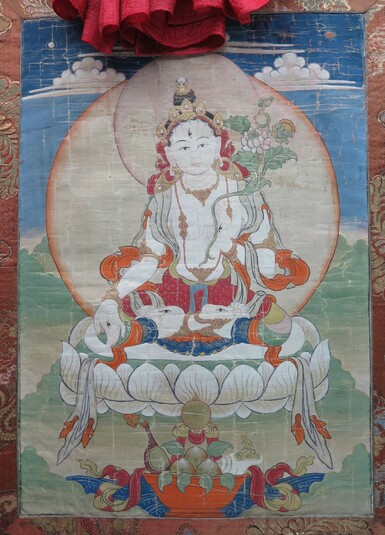
Item: Tara (Buddhist Deity) - White
| Origin Location | Tibet |
|---|---|
| Date Range | 1800 - 1899 |
| Lineages | Buddhist |
| Material | Ground Mineral Pigment on Cotton |
| Collection | Private |
Classification: Deity
Appearance: Peaceful
Gender: Female
White Tara (Tibetan: drol ma kar mo, English: the White Liberator): a form of Tara, she is a meditational deity and her special function or activity is to increase life span and promote physical health to those devoted practitioners. The other forms of Tara also have different but specific special functions.
White Tara is commonly depicted in a group of three known as the Three Long-life Deities. (See the Long Life Deities Outline Page).
The special and noteworthy characteristics of this figure are the oval face signifying that it is a female form along with the extra eyes seen on the forehead, the two palms of the hands and the two soles of the feet.
Within the Tantric system of Mahayana Buddhism Tara is considered a female Buddha in Peaceful Appearance. In her white form she is the female Buddha of longevity. According to the texts that discuss the history of Tara, she is a completely enlightened buddha and as a young bodhisattva she had promised always to appear in the form of a female bodhisattva for the benefit of all beings and especially to protect from the eight fears. In this white form she appears specifically for the purpose of bestowing longevity. Practised in all Schools of Tibetan Buddhism Tara is second in popularity only to Avalokiteshvara. Her practices are found in all classes of tantra - Nyingma and Sarma.
"...with a hue white like an autumn moon - radiant like a stainless crystal jewel, shining with rays of light, one face, two hands, and having three eyes; with the conduct of having sixteen years of age. The right hand is in the mudra of supreme generosity; the left holds with the thumb and forefinger the stem of a white utpala to the heart with the petals blossoming at the ear. Representing the buddhas of the three times the single stem is divided into three, in the middle is a blossoming flower, the right in fruition, the left in the form of a bud; adorned with various jewel ornaments; having various silk upper garments and a lower garment of red silk; seated with the legs in vajra posture. The palms of the hands and feet each have an eye - the seven eyes of pristine awareness." (Sachen Ngagwang Kunga Lodro, 1729-1783).
At the lower front of the composition there is a large bowl containing the visual representations of the Five Objects of the Senses, also known as the Five Qualities of Enjoyment: mirror, lute, incense vessel, fruit and silk.
Jeff Watt 12-2015
Buddha Form | Female Form | Wrathful Form
Buddhist Deity: Tara, White Main Page
Exhibition: Female Form (DM)
Collection of Dhargye Museum (Painting Gallery 1)
Buddhist Deity: Tara Main Page
Collection of Dhargye Museum

